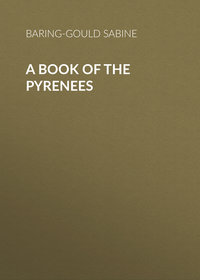 полная версия
полная версияCornish Characters and Strange Events
The prisoner upon this was remanded to Bodmin gaol, where his brother was already confined, and on the way he pointed out the furze bush in which the tablet and the keys of the deceased were to be found. James Lightfoot, in the meantime, had also made a confession, in which he threw the guilt of the murder upon his brother William.
This latter, when in prison, admitted that his confession had not been altogether true. He and his brother had met by appointment, with full purpose to rob the Rev. W. Molesworth, of S. Breock, returning from Bodmin market, and when James had snapped his pistol twice at Mr. Norway, he, William, had struck him with a stick on the back of his head and felled him from his horse, whereupon James had battered his head and face with the pistol.
The two wretched men were tried at Bodmin on March 30th, 1840, before Mr. Justice Coltman, and the jury returned a verdict of "Guilty"; they were accordingly both sentenced to death, and received the sentence with great stolidity.
Up to this time the brothers had been allowed no opportunity for communication, and the discrepancy in their stories distinctly enough showed that the object of each was to screen himself and to secure the conviction of the other.
After the passing of the sentence on them, they were conveyed to the same cell, and were now, for the first time, allowed to approach each other. They had scarcely met before, in the most hardened manner, they broke out into mutual recrimination, using the most horrible and abusive language of each other, and, not content with this, they flew at each other's throat, so that the gaolers were obliged to interfere and separate them and confine them in separate apartments.
On April 7th their families were admitted to bid them farewell, and the scene was most distressing. On Monday morning, April 13th, they were both executed, and it was said that upwards of ten thousand persons had assembled to witness their end.
As Mr. Norway's family was left in most straitened circumstances, a collection was made for them in Cornwall, and the sum of £3500 was raised on their behalf.
William Lightfoot was aged thirty-six and James thirty-three when hanged at Bodmin.
There is a monument to the memory of Mr. Norway in Egloshayle Church.
In the Cornwall Gazette, 17th April, 1840, the portraits of the murderers were given. Mention is made of the tragedy in C. Carlyon's Early Years, 1843. He gives the following story. At the time of the murder, Edmund Norway, the brother of Nevill, was in command of a merchant vessel, the Orient, on his voyage from Manilla to Cadiz. He wrote on the same day as the murder: —
"Ship Orient, from Manilla to Cadiz,"Feb. 8th, 1840."About 7.30 p.m. the island of S. Helena, N.N.W., distant about seven miles, shortened sail and rounded to, with the ship's head to the eastward; at eight, set the watch and went below – wrote a letter to my brother, Nevell Norway. About twenty minutes or a quarter before ten o'clock went to bed – fell asleep, and dreamt I saw two men attack my brother and murder him. One caught the horse by the bridle and snapped a pistol twice, but I heard no report; he then struck him a blow, and he fell off the horse. They struck him several blows, and dragged him by the shoulders across the road and left him. In my dream there was a house on the left-hand side of the road. At five o'clock I was called, and went on deck to take charge of the ship. I told the second officer, Mr. Henry Wren, that I had had a dreadful dream, and dreamt that my brother Nevell was murdered by two men on the road from S. Columb to Wadebridge; but I was sure it could not be there, as the house there would have been on the right-hand side of the road, but it must have been somewhere else. He replied, 'Don't think anything about it; you West-country people are superstitious; you will make yourself miserable the remainder of the passage. He then left the general orders and went below. It was one continued dream from the time I fell asleep until I was called, at five o'clock in the morning.
"Edmund Norway,"Chief Officer, Ship Orient."There are some difficulties about this account. It is dated, as may be seen, February 8th, but it must have been written on February 9th, after Mr. Norway had had the dream, and the date must refer to the letter written to his brother and to the dream, and not to the time when the account was penned.
From the Cape of Good Hope to S. Helena the course would be about N.N.W., and with a fair wind the ship would cover about eighty or ninety miles in eight hours. So that at noon of the day February 8th she would be about one hundred miles S.S.E. of S. Helena, i.e. in about 5° W. longitude, as nearly as possible. The ship's clock would then be set, and they would keep that time for letter-writing purposes, meals, ship routine, etc.

The difference would be twenty minutes of longitude, and the difference in time between the two places one degree apart is four minutes. Reduce this to seconds: —

Therefore, if the murder was committed, say, at 10h. 30m. p.m. Bodmin time, the time on the ship's clock would be 10h. 28m. 40s. p.m. An inconsiderable difference.
The log-book of Edmund Norway is said to be still in existence.
One very remarkable point deserves notice. In his dream Mr. Edmund Norway saw the house on the right hand of the road, and as he remembered, on waking, that the cottage was on the left hand, he consoled himself with the thought that if the dream was incorrect in one point it might be in the whole. But he was unaware that during his absence from England the road from Bodmin to Wadebridge had been altered, and that it had been carried so that the position of the house was precisely as he saw it in his dream, and the reverse of what he had remembered it to be.
Another point to be mentioned is that one of the murderers wore on that occasion a coat which Mr. Norway had given him a few weeks before, out of charity.
Both brothers protested that they had not purposed the murder of Mr. Norway but of the Rev. Mr. Molesworth, parson of S. Breock, who they supposed was returning with tithe in his pocket. This, however, did not agree with the evidence that William Lightfoot had watched him counting his money at Bodmin, and then had made off.
On the occasion of the discovery of the murder, Sir William Molesworth sent his bloodhounds to track the murderers, but because they ran in a direction opposed to that which the constables supposed was the right one they were recalled. The hounds were right, the constables wrong.
SIR WILLIAM LOWER, KNT
Sir William Lower was the only son of John Lower, and was born at Tremere, in S. Tudy, about the year 1600.
The Lowers were a very ancient family in Cornwall, seated in S. Winnow parish, and at Clifton, in Landulph, at which latter place lived Sir Nicholas Lower, the brother of John, whilst the eldest brother, Sir William, settled at Treventy, in Carmarthen, having married the daughter and co-heiress of Sir Thomas Pescott, of that place. John had two other brothers knights, Sir Francis and Sir Thomas.
William was not educated at Oxford, but, as Wood says, "spent some time in Oxon, in the condition of hospes, for the sake of the public library and scholastical company." He exhibited a "gay fancy," and a mighty aversion from the dry and crabbed studies of logic and philosophy.
Leaving Oxford, he spent some time in France, where he became a master of the French tongue, and acquired a great admiration for the dramatic compositions of Corneille, Quirault, and Ceriziers, and in after years amused himself with translating some of their plays.
When the troubles broke out in England he took the King's side, and in 1640 was a lieutenant in Sir Jacob Ashley's regiment in Northumberland's army against the Scotch Covenanters, and was then appointed captain, but lost his company, that proved mutinous and deserted. "It was a marvellous thing," says a writer of the time, "to observe the averseness of the common soldiers to this war. Though commanders and gentlemen of great quality, in pure obedience to the King, seemed not at all to dispute the cause or consequence of this war, the common soldiers would not be satisfied, questioning, in a mutinous manner, whether their captains were papists or not, and in many places were not appeased till they saw them receive the sacrament; laying violent hands on divers of their commanders, and killing some, uttering in bold speeches their distaste of the cause, to the astonishment of many, that common people should be sensible of public interest and religion, when lords and gentlemen seemed not to be."
In June, 1644, being a lieutenant-colonel in Thomas Blague's regiment and lieutenant-governor of Wallingford, Lower received orders from the King to raise £50 a week from the town of Reading. Lower at once laid hands on the mayor and carried him to Wallingford as a hostage; he then plied the corporation with demands for the money, without which their head would not be restored to them. The corporation, however, did not value their mayor so highly that they were disposed to pay £50 per week for the privilege of having him restored to them. Lower was taken prisoner by the garrison of Abingdon on 19th January, 1645-6, and Charles rewarded him for his zeal by conferring on him knighthood.
He remained in England for nearly ten more years and saw the ruin of the Royal cause, which he did care for, and of the Church, for which he cared not a rush. In 1655 he quitted England and went to Cologne, which was full of refugees, and there he was cheered with the tidings that Oliver Cromwell was failing in health and had not long to live. Leaving Cologne, after a brief residence there, he "took sanctuary in Holland, where in peace and privacy he enjoyed the society of the Muses," says Langhorn.
His The Phœnix in Her Flames, a tragedy in four acts, had been published in 1639. The Innocent Lady, or the Illustrious Innocence, translated from the French of R. de Ceriziers, was published in 1654. Now in Holland he worked hard at other translations, and he was the more able to do this at ease, as the Princess Royal Mary of Orange seems to have taken him into her retinue at the Hague. If the Court was anything like what it was when James Howell was there, it must have been vastly dull for the lively and dissolute Sir William Lower. But his stay was enlivened by the arrival of Charles and the intrigues there carried on with the well-affected in England.
At the Hague he issued a thin royal folio, with many plates, entitled "A relation in form of Journal of the voiage and residence which the most excellent and most mighty Prince, Charles the II, King of Great Britain, etc., hath made in Holland, from the 25th of May to the 2nd of June, 1660, rendered into English from the original French. By Sir W. Lower, Knt. Printed by Adrian Ulack." This was published in Dutch, French, and English, and at the end of the volume Sir W. Lower inserted his poems, and an apology for the "tardive appearance (of the book) due to those men who grave the plates."
Such "poems" as he has given as his own show conclusively enough that he was not a poet, but a mere hammerer together of rhymes.
In June, 1660, calculating on his services rendered to Charles I and to the sumptuous book on the residence in Holland of Charles II that he had brought out, Lower appealed to Secretary Nicholas from The Hague to obtain for him some place in the King's service. But the death of his cousin Thomas, only son of Sir William Lower, of Treventy, who died on 5th February, 1661, by which he became sole heir, executor, and chief representative of the family, recalled him to England. He did not, however, enjoy ease long, for he died in the ensuing year, 1662, leaving an only child, Elizabeth, who probably died early, for nothing further is known of her than that she was in existence when her father died. Who the wife of Sir William Lower was is not known.
His cousin, Dr. Richard Lower, of S. Paul's, Covent Garden, who gave Wood information relative to his kinsman, described him as "an ill poet and a worse man."
His long residence abroad, his dissociation from Cornwall for all his life save his early boyhood, his separation from his kinsmen, had broken all the ties that linked him to his family and county; and when he inherited the estates and was in a position to assist his kinsmen who had been greatly reduced by the civil wars, "he did not, but followed the vices of poets."
THE PIRATES AT PENZANCE
An event occurred at Penzance in the year 1760 that deserves to be remembered. Great Britain had been engaged in the Seven Years War; and notwithstanding the successes of 1759, when Rodney bombarded Havre, Boscawen had routed and dispersed the Toulon fleet off Lagos, and Hawke had defeated the fleet of De Conflans near Quiberon, there was still a certain amount of alarm in the country, a dread of predatory incursions, and if this fear existed inland, it was most acute upon the coast.
On the night of the 29-30th September Penzance was alarmed by the firing of guns, and soon after by the intelligence that a large ship of a strange appearance had run ashore near Newlyn. Half Penzance poured out in that direction in the grey of early morning. But on reaching the strand they were panic-stricken to see on the ship, and drawn up on the beach, a number of ferocious-looking individuals with baggy trousers, and red fezes on their heads, and each armed with a scimitar, and with brass-mounted pistols stuck in their girdles. Thereupon the half of Penzance that had turned out now turned tail and made the best of their way back to the town, crying out that the Turks had landed and were intent on massacring the inhabitants of Penzance, plundering their houses, and carrying away their wives and children into captivity to become galley-slaves or to fill the harems of these Moslem monsters.
A volunteer company was called out, the drum beat to arms, and marched to the beach, where they found 172 men, who were surrounded, deprived of their weapons, and marched to a spacious building called "The Folly," that stood on the Western Green. As there were some of the captives who could speak the lingua franca, and there was here and there to be found a magistrate or an officer who had a limited knowledge of French, it was at last elicited from these men that they were the crew of an Algerine corsair, carrying twenty-four guns, from nine to six pounders. The captain, believing himself to be in the Atlantic, somewhere about the latitude of Cadiz, had cheerily in the dark run his vessel into Mount's Bay, and was vastly surprised when she struck, and still more so when he found himself surrounded by Cornishmen and not by Spaniards. He had lost eight men, drowned.
No sooner was this bruited about than a second panic set in, and the good citizens of Penzance went into hysterics of fear lest these Algerine pirates should have brought with them an invasion of the plague.
A cordon of volunteers was accordingly drawn up round "The Folly" to prevent all intercourse, intelligence was conveyed to the Government, and orders were issued for troops to march from Plymouth so as to surround the whole district. However, the local authorities recovered from their terror or apprehension in time to send off information that there was no cause for such a measure, and the orders were countermanded.
After some days, when no case of plague had revealed itself among the captives, the people of the town and neighbourhood were suffered to approach and contemplate the strangers. Their Oriental dress, their long beards and moustaches, the dark complexion and glittering eyes of the piratical band, made them objects of curiosity. But they still inspired so much fear that few ventured to approach near to them.
Upon the whole, they were kindly treated, and finally, as their vessel was a complete wreck, a man-of-war was despatched to take all the men on board and convey them back to Algiers.
DAME KILLIGREW
The Killigrew family is one of the most ancient in Cornwall. It takes its name from Killigrew in the parish of S. Erme. Here stands the old nest of the family beside the high road from Truro that falls into that from Redruth to Bodmin at Casland. It is now represented by a couple of insignificant cottages, without old trees surrounding it, and the only hint that it was once the seat of a distinguished family is found in the remains of the deerpark.
The genuine pedigree of the family goes back to Ralph Killigrew of Killigrew, in the reign of Henry III. In that of Richard II, Simon Killigrew married Jane, daughter and heiress of Robert of Arwenack, near Penryn, and he quitted the ancestral mansion to move to his wife's house that was planted in a less bleak situation and was on the estuary of the Fal.
In the reign of Queen Elizabeth, Sir John Killigrew of Arwenack, was Captain in Command of Pendennis Castle. He married Mary, daughter of Philip Wolverston and widow of Henry Knyvett of an Eastern counties family, but her son by Henry Knyvett settled in Cornwall, at Rosemorryn in S. Budoc. Sir John pulled down the greater portion of the ancient house and built himself another, very stately in the style of the times – but, alas! this also has disappeared, for when Sir William Waller approached Pendennis, to besiege it on behalf of the Parliament, the Governor of the Castle set fire to Arwenack lest it should give harbour to the enemy.
Sir John had a son, also called John, who married Dorothy, daughter of the impecunious Sir Thomas Monck, Knt., of Potheridge, which Sir Thomas died in the debtors' gaol at S. Thomas', by Exeter. John and Dorothy had a son, Sir John Killigrew, aged twenty-two on his father's death in 1605.
Now it fell out that Sir Walter Raleigh on his homeward voyage from Guiana put into Falmouth harbour, and found there, where the town now stands, only a fisherman's cottage. Killigrew, however, hospitably entertained Sir Walter, who expressed his surprise that so fine a harbour should have no accommodation for sailors sheltering there, and when he went to town memorialized King James on the subject. He had fired the imagination of his host, Sir John, and he also petitioned the King to grant him a royal licence to build four houses, where now stands Falmouth, for the convenience of sailors. This roused the wrath of the people of Penryn further up the river, who saw that four houses would bring in their wake many more, and would draw away the trade, and cut off the prosperity of Penryn. Accordingly they used every possible endeavour to obstruct the project. Sir John made several journeys to London, but it was only by spending a great deal of money in fees and bribery of officials that he was able to obtain the licence; and by so doing he incurred the implacable resentment of the inhabitants of Penryn.
We will now let Martin Killigrew continue the story. He wrote a history of the family in 1737 or 1738. We will somewhat simplify the reading by giving "the" for "ye."
"The last Sir John Killigrew was hardly got over this difficulty, when he fell under a much greater affliction, the prostitution of his wife, who caused herself to be called, or unaccountably was known by the name of Lady Jane." He has already stated, "Sir John Killigrew, a sober, good man, to his utter undoing, married the daughter of an ancient and honourable family, new in the peerage, in respect to whom I forbear the name; making herself infamous, and first debauched by the Governor of Pendennis Castle." This lady was Jane, daughter of Sir George Fermon, of Northampton. Sir William, his brother, was created Baron Leominster in 1622, whose son was given the earldom of Pomfret in 1721.
"Arrived to that shameful degree, Sir John, in point of honour and for quietness of mind, found himself under a necessity to prosecute a divorce from her in the Archbishop's Court, which lasted so many years and [was] so very expensive, as quite ruined his estate, to the degree of his being often put to very hard shifts to get home from London upon the frequent recesses in the process, but at length obtained the divorce in all its formal extent. This woman in such long contest was in no degree protected by her family, but supported and cherished by the town of Penryn, from their jealousy and hatred of Arwenack, as specially appears to this day, by plate by her given to the Mayor and Corporation of Penryn, when she came into her jointure, as an acknowledgment for such protection.11 Sir John did not long outlive such his divorce, dying in 1632."
Hals says: "Jane Killigrew, widow of Sir John Killigrew, Knt., in the Spanish wars in the latter end of the reign of Queen Elizabeth, went on board two Dutch ships of the Hans Towns (always free traders in times of war) driven into Falmouth harbour by cross winds, laden with merchandise, on account (as was said) of Spaniards, and with a numerous party of ruffians, murdered the two Spanish merchants or factors on board these ships, and took from them two barrels or hogsheads of Spanish pieces of eight, and converted them to her own use."
"Now, though Fleta (lib. i. c. iii., temp. Edward II) tells us that it is no murder except it be proved that the party slain was English, and no stranger, yet afterwards by the statute 4 Edward III, the killing any foreigner under the King's protection, out of evil design or malice, is murder; upon which statute these offenders were tried and found guilty at Launceston of wilful murder, both by the grand and petty juries, and had sentence of death passed accordingly upon them, and were all executed, except the said Lady Killigrew, the principal agent and contriver of the barbarous fact, who, by the interest and favour of Sir John Arundell, of Tolverne, Knt., and his son-in-law, Sir Nicholas Hals, of Pengersick, Knt., obtained of Queen Elizabeth a pardon or reprieve for the said lady, which was seasonably put into the Sheriff of Cornwall's hands.
"At the news whereof the other condemned wretches aforesaid at the gallows lamented nothing more than that they had not the company of that old Jezebel Killigrew at that place as in justice they ought to be (to use their own words), and begged Almighty God that some remarkable judgment might befall her and her posterity, nay, and all those that were instrumental in procuring her freedom, and observed hereupon it was, that her grandson Sir William Killigrew spent the whole paternal estate of his ancestors, as did Sir Thomas Arundell, Knt., son of Sir John Arundell, aforesaid, and John Hals, Esq., son of Sir Nicolas Hals, Knt., in their own times, but alas, several and public revolutions of this kind; and all other in worldly affairs are carried on by the judgment and providence of God, not the determination of men, especially such barbarous ruffians as these criminals, though these things happened according to the malefactors' direful imprecations in some sense."
Hals in the above account makes several blunders. The affair to which he alludes took place in January, 1583, and the Dame Killigrew who was involved in it was Mary, wife of Sir John, the grandfather of the Sir John who divorced his wife Jane. Another mistake is that the ship was not one of the Hanseatic town merchant vessels, but was Spanish. Moreover, Hals is wrong in saying that the two Spanish merchants were murdered. On the contrary, Lady Killigrew's ruffians threw overboard and drowned the whole ship's crew, with the exception of the two merchants, who were on shore and so escaped.
The facts are as follows: —
The Mary of S. Sebastian, a Spanish ship of 144 tons burden, owned by two merchants, John de Chavis and Philip de Oryo, the latter being as well the captain, arrived in Falmouth harbour on January 1st, 1582-3, and cast anchor within the bar, just under Sir John Killigrew's house of Arwenack. Here for lack of wind it remained, and the owners went on shore and took up their quarters in an inn at Penryn, awaiting a favourable breeze. At this time there was no open breach of peace between England and Spain. It was not till 1585 that Elizabeth sent over an army into the Netherlands to oppose the forces of Philip II, and despatched a fleet under Sir Francis Drake into the West Indies to molest the Spanish galleons and colonies there.











